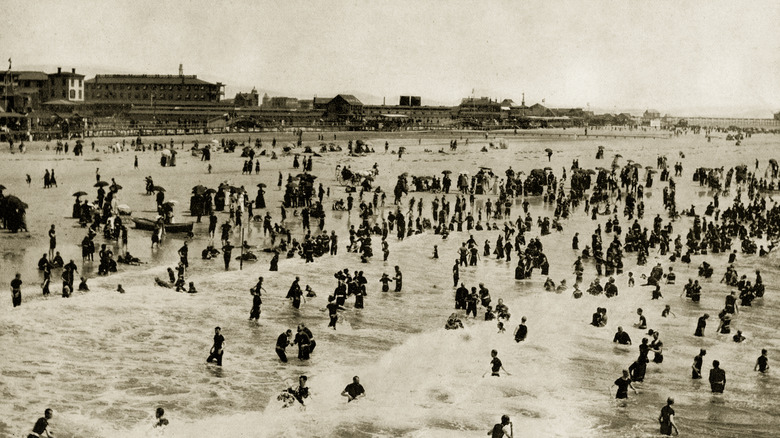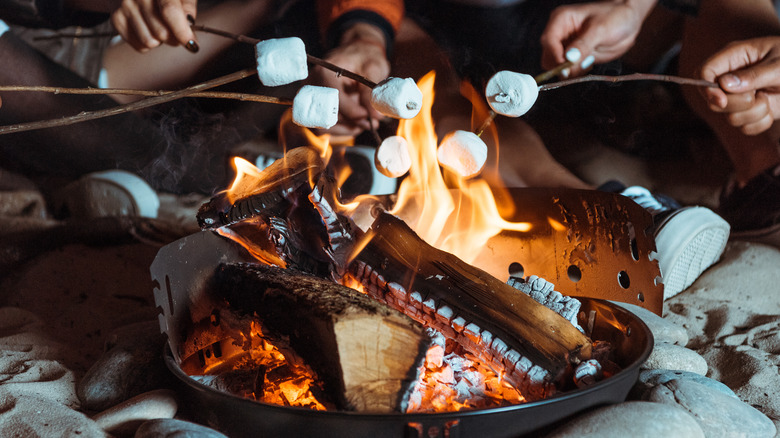The Jersey Shore Origins Of Roasting Marshmallows On A Campfire
Once deeply explored, one can find many interesting motivations and incidents behind some of our favorite foods. In the late 19th century, one northeast newspaper suggested (as covered by the CBC) that the process of making a particularly popular treat may have been developed to "amuse the ennuied summer girl." And that boredom-busting snack is the roasted marshmallow.
The Rochester Daily Republican writer may have seen this practice as simply a passing fad for unimpressed teenage girls to while away a few nights at the beach. But they could never have anticipated just how enduring a ritual can be — especially when it combines conviviality, spectacle, an engaging activity, and of course, deliciousness. The Jersey Shore — the 90-mile stretch of coastline in Southern New Jersey — has long been known as a destination for summer travelers, thanks to amusement parks and sandy beaches. But in the late 1800s, it was the perfect scene for young people on vacation with their families to plop down around a campfire, pop marshmallows on sticks, and engage in what that same Rochester writer called a "refined species of entertainment."
Jersey Shore ritual history
As it turns out, marshmallows themselves have been around since ancient times. Although they likely looked and tasted very different, some versions of this culinary creation date back to ancient Greece, when the marsh mallow plant was tapped for its reported medicinal qualities (including claims ranging from cough suppression to anti-inflammatory properties).
The mallows young people were probably firing up in the 1890s on the Jersey Shore may have been similar to today's squishy treats in terms of ingredient list (sugar, egg whites, flavoring), they were still an antecedent. This was before efficiency-boosting extruder technology and widespread access to sugar — some of the factors that made marshmallows economically accessible to the mainstream. That means that this ritual was probably conducted mostly by people with money and the means to not only take these summer holidays, for which Atlantic City and other Jersey Shore hot spots were becoming notable, but also invest in a treat that they didn't mind setting on fire. Perhaps the sheer spectacle, the delight of watching as the mallow puffed and charred, cheering on their fellow roasters, was worth the investment.
It's hard to know what these originators would have contributed to the conversation when Twitter debated how to roast the perfect marshmallow, or if they'd appreciate going a step further with a classic s'mores. Regardless of their methods or what compelled them to the campfire, today's marshmallow lovers can appreciate their legacy.
Early days mallow math and a lasting legacy
It turns out that high-brow Jersey Shore vacationers weren't the only ones who made marshmallow-roasting a national pastime. Teddy Roosevelt — just before taking his role as the President of the United States – was a figurehead for a national community of campers. And as that practice became more popular, these intrepid trekkers took to the fire with their treats, spreading the idea of roasting marshmallows around the country. Even the Boy Scouts of America got involved, with the July 1924 issue of the organization's journal (titled "Boys Life") suggesting that "Eating marshmallows is an exercise that every scout knows perfectly well how to perform."
As the snack traveled and became more popular, the makeup of the mallow evolved, too. While the French had a meringue-based version made with rose water and mallow plant sap back in the 19th century, the more modern American interpretation reimagined the treat with ingredients that were more accessible (including corn syrup and gelatin), which made it easier for companies to make them and market to the masses. By the time the Campfire brand of marshmallows hit shelves in 1917, the packaging itself made a suggestion to set the product over a blaze for an unforgettable spin (and a spectacle to boot). But it wasn't until the 1950s that marshmallows became truly egalitarian, thanks to the jet-puff — a patented process that streamlined their creation and resulted in the airy mallow we love to roast today.


